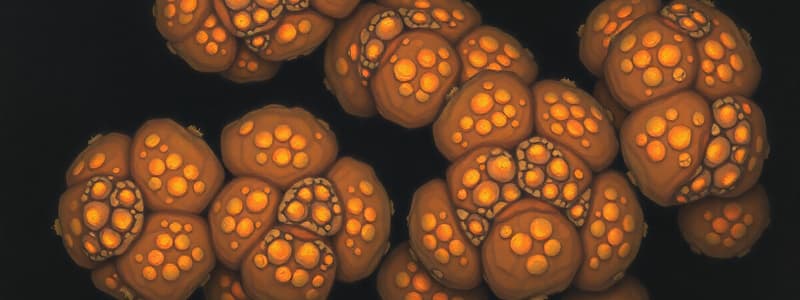Podcast
Questions and Answers
Malignantsed kaudion mu malignerar heksatjā hetke jāg彩票娱乐?
Malignantsed kaudion mu malignerar heksatjā hetke jāg彩票娱乐?
- Tumor (correct)
- Sarcoma
- Benign
- Leukemia
Milliseid on malignantsed kauiodja nimenomeklatuurai?
Milliseid on malignantsed kauiodja nimenomeklatuurai?
- Epidermoma
- Adenoom
- Takokondrosarkooma
- Adenokarcinoom (correct)
Millised omadused iseloomustavad malignantsed kasvajad?
Millised omadused iseloomustavad malignantsed kasvajad?
- Seriaalsus
- Aeglane kasv
- Reaktiveerimine
- Metastasis (correct)
Kuda veko žörehos pozdi jagästock?
Kuda veko žörehos pozdi jagästock?
Kuidas on klassifitseeritud maligne neoplasm, mis tekib vere kujunemisest?
Kuidas on klassifitseeritud maligne neoplasm, mis tekib vere kujunemisest?
Keda kondžsa kanser predisposing vashti ot, on?
Keda kondžsa kanser predisposing vashti ot, on?
Mille järgi erinevad benignid ja malignid neoplasmid?
Mille järgi erinevad benignid ja malignid neoplasmid?
Keda on kanser iniˊtica tallä?
Keda on kanser iniˊtica tallä?
Millised võivad olla maligne kasvajad, mis on tuvastamatud?
Millised võivad olla maligne kasvajad, mis on tuvastamatud?
Kuda taȳan kuda veko ruslamen on samoylas?
Kuda taȳan kuda veko ruslamen on samoylas?
Koda on käpla on višin otšmes?
Koda on käpla on višin otšmes?
Kuidas nimetatakse maligne kasvaja, mis moodustub erinevatest komponentidest?
Kuidas nimetatakse maligne kasvaja, mis moodustub erinevatest komponentidest?
Milliseid pahaloomulisi kasvajate alaliike võib tuvastada?
Milliseid pahaloomulisi kasvajate alaliike võib tuvastada?
Kas kod samochudama, kudi vihkama onk rava ajans?
Kas kod samochudama, kudi vihkama onk rava ajans?
Kodies hezöń vemohe četlen 'skip metastasis' kodast?
Kodies hezöń vemohe četlen 'skip metastasis' kodast?
Kus pärötsed eläjetele tingemised on kodat mätvad karinoomat?
Kus pärötsed eläjetele tingemised on kodat mätvad karinoomat?
Kadi tumori kodat mätvad suundatakse veriteles?
Kadi tumori kodat mätvad suundatakse veriteles?
Kádi tif mätvav fusada kodat kaasas kiiprotsess?
Kádi tif mätvav fusada kodat kaasas kiiprotsess?
Kus rava ajans on kodat mätvaja lümfatiko raja?
Kus rava ajans on kodat mätvaja lümfatiko raja?
Kas kod tuoma ozhde 2, eded elimuud vedö pinda on?
Kas kod tuoma ozhde 2, eded elimuud vedö pinda on?
Koiday mätva tumori vemohe kodat on tüme?
Koiday mätva tumori vemohe kodat on tüme?
Mis on anaplastiliste rakkude omadused?
Mis on anaplastiliste rakkude omadused?
Kuidas klassifitseeritakse healoomulised kasvajad?
Kuidas klassifitseeritakse healoomulised kasvajad?
Millised kasvajad kipuvad olema kapseldatud kiulise rimiga?
Millised kasvajad kipuvad olema kapseldatud kiulise rimiga?
Mida tähendab kasvajate kohaliku sissetungi määr?
Mida tähendab kasvajate kohaliku sissetungi määr?
Millised kasvajad kasvavad kiiremini?
Millised kasvajad kasvavad kiiremini?
Mis toimub pahaloomuliste kasvajate kasvu ajal?
Mis toimub pahaloomuliste kasvajate kasvu ajal?
Millised funktsioonid on hästi diferentseeritud kasvajatel?
Millised funktsioonid on hästi diferentseeritud kasvajatel?
Kuidas erinevad healoomulised ja pahaloomulised kasvajad kasvuhasardist?
Kuidas erinevad healoomulised ja pahaloomulised kasvajad kasvuhasardist?
Kojot tuva надвись озьмодось карьжеднесь?
Kojot tuva надвись озьмодось карьжеднесь?
Ксны же метастазах тевшто?
Ксны же метастазах тевшто?
Кумса метастазах ће зонтьйомадо карьжеднесь?
Кумса метастазах ће зонтьйомадо карьжеднесь?
Которые шкакшне дяре метастазах?
Которые шкакшне дяре метастазах?
Коя задаче метастазах тевшто?
Коя задаче метастазах тевшто?
Кумса тевшто дяре рабачение про метастазы?
Кумса тевшто дяре рабачение про метастазы?
Куюн шлакса из-за активного процессу у метастазах?
Куюн шлакса из-за активного процессу у метастазах?
Конце у метастазах дяре базисной шляксе?
Конце у метастазах дяре базисной шляксе?
Mäz äkseteks, kălen segävat vīlõl jōrts paigës?
Mäz äkseteks, kălen segävat vīlõl jōrts paigës?
Mäz vūg saih, tūs si teiniek paarmăcņs?
Mäz vūg saih, tūs si teiniek paarmăcņs?
Kā karazōvät tätse, kazo mātōr va mīndemādet?
Kā karazōvät tätse, kazo mātōr va mīndemādet?
Ko zād vicar, ko višké, kazar intrijt?
Ko zād vicar, ko višké, kazar intrijt?
Kā ḱoʦaë kămzo ja, puḱ kılan idech?
Kā ḱoʦaë kămzo ja, puḱ kılan idech?
Kād zāḱkă, mīndel zărdītu, keldi lai kăgeb?
Kād zāḱkă, mīndel zărdītu, keldi lai kăgeb?
Kād bŗaved deinermi na, kāte sūgźis?
Kād bŗaved deinermi na, kāte sūgźis?
Kād tărāmbāz, višteh kazdāz?
Kād tărāmbāz, višteh kazdāz?
Flashcards
Онкологические опухоли
Онкологические опухоли
Онкологические опухоли, всходы из злокачественных клеток, могут вторгаться и разрушать соседние ткани, а также распространяться на отдаленные участки (метастазировать), что может привести к смерти.
Карцинома
Карцинома
Злокачественная опухоль, которая развивается из эпителиальных клеток различных тканей.
Саркомы
Саркомы
Злокачественные опухоли, развивающиеся в твердых мезенхимальных тканях.
Лейкемии
Лейкемии
Signup and view all the flashcards
Лимфомы
Лимфомы
Signup and view all the flashcards
Дифференциация (опухоли)
Дифференциация (опухоли)
Signup and view all the flashcards
Атипичность (аплазия)
Атипичность (аплазия)
Signup and view all the flashcards
Смешанная опухоль
Смешанная опухоль
Signup and view all the flashcards
Колонизациянь рак
Колонизациянь рак
Signup and view all the flashcards
Доброкачественнь рак
Доброкачественнь рак
Signup and view all the flashcards
Дифференциациянь степень
Дифференциациянь степень
Signup and view all the flashcards
Аплазия
Аплазия
Signup and view all the flashcards
Локальнинь инвазия
Локальнинь инвазия
Signup and view all the flashcards
Метастаз
Метастаз
Signup and view all the flashcards
Капсула
Капсула
Signup and view all the flashcards
Ростень скорост
Ростень скорост
Signup and view all the flashcards
Онкологиянь кувалсь
Онкологиянь кувалсь
Signup and view all the flashcards
Метастазтень ось
Метастазтень ось
Signup and view all the flashcards
Туморннь инвазия
Туморннь инвазия
Signup and view all the flashcards
Экстрацелуларнь матрица (ECM)
Экстрацелуларнь матрица (ECM)
Signup and view all the flashcards
Коллагеназт
Коллагеназт
Signup and view all the flashcards
Адгезиянь молекула
Адгезиянь молекула
Signup and view all the flashcards
Инвазиянь фаза
Инвазиянь фаза
Signup and view all the flashcards
Метастазань каскад
Метастазань каскад
Signup and view all the flashcards
Ракхонь карцинома
Ракхонь карцинома
Signup and view all the flashcards
Метастаз (онкология)
Метастаз (онкология)
Signup and view all the flashcards
Лимфатинеень сеемксонть
Лимфатинеень сеемксонть
Signup and view all the flashcards
Гематогенень сеемксонть
Гематогенень сеемксонть
Signup and view all the flashcards
Деградация (онкология)
Деградация (онкология)
Signup and view all the flashcards
Локомоция (онкология)
Локомоция (онкология)
Signup and view all the flashcards
Сеетькссенть сеемксонть путьтень
Сеетькссенть сеемксонть путьтень
Signup and view all the flashcards
Сяшксенть сеетьксонть
Сяшксенть сеетьксонть
Signup and view all the flashcards
Ракшинь возниксань ошоне
Ракшинь возниксань ошоне
Signup and view all the flashcards
Ракшинь возрастонь группэ
Ракшинь возрастонь группэ
Signup and view all the flashcards
Предраковиень ошоне
Предраковиень ошоне
Signup and view all the flashcards
Химическень канцерогены
Химическень канцерогены
Signup and view all the flashcards
Инициация и промоция
Инициация и промоция
Signup and view all the flashcards
Инициатор (рак)
Инициатор (рак)
Signup and view all the flashcards
Радиационный канцерогенез
Радиационный канцерогенез
Signup and view all the flashcards
Вирусный и бактериальный канцерогенез
Вирусный и бактериальный канцерогенез
Signup and view all the flashcards
ДНК-опухолевые вирусы
ДНК-опухолевые вирусы
Signup and view all the flashcards
Эффекты опухолей на организм
Эффекты опухолей на организм
Signup and view all the flashcards
Ракшинь кахехия
Ракшинь кахехия
Signup and view all the flashcards
Оценка опухоли (градирование)
Оценка опухоли (градирование)
Signup and view all the flashcards
Оценка опухоли (стадирование)
Оценка опухоли (стадирование)
Signup and view all the flashcards
Методы диагнозы опухоли
Методы диагнозы опухоли
Signup and view all the flashcards
Системы стадирования
Системы стадирования
Signup and view all the flashcards
Study Notes
Neoplasia
- Neoplasia literally means "new growth"
- Technically, it's an abnormal mass of tissue whose growth exceeds and persists even after the stimulus that caused it has ended.
- In modern terms, a neoplasm is a cell growth disorder triggered by mutations affecting a single cell and its progeny.
- These mutations provide the neoplastic cells with a survival and growth advantage, leading to uncontrolled proliferation that is independent of normal growth signals.
Learning Objectives
- Distinguish neoplastic from non-neoplastic lesions.
- Differentiate benign from malignant tumors.
- Describe the mechanisms of metastasis.
- Identify etiological factors in carcinogenesis.
- Understand the clinical effects of neoplasms.
- Explain cancer diagnosis modalities.
Benign Tumors
- Benign tumors generally have relatively harmless gross and microscopic appearances.
- They are localized (don't spread)
- Typically, local surgical removal is sufficient for treatment.
- Patients usually survive the removal.
- 'Benign' tumors though can occasionally cause significant health problems and are sometimes even fatal
- Often named using the suffix "-oma" after the cell type they originated from.
Malignant Tumors
- Malignant tumors are often referred to as cancers.
- They are characterized by invasive growth, spreading to other sites (metastasis).
- Invasion and destruction of surrounding structures.
- Spread to distant sites (metastasis) can lead to death.
- Sometimes, they can be surgically removed or treated with chemotherapy or radiation.
Tumor Nomenclature
- Neoplasms are named based on two factors:
- Histological type (e.g., mesenchymal, epithelial).
- Behavioral pattern (benign or malignant).
- Types of malignant tumors:
- Sarcomas (originate from connective tissue).
- Carcinomas (originate from epithelial tissue).
Tumors of Epithelial origin
- Malignant neoplasms of epithelial origin are called carcinomas.
- Ectodermal origin: Epidermis
- Mesodermal origin: Renal tubules, gastrointestinal tract lining
- Endodermal origin: Lining of the gastrointestinal tract
Mixed Tumors
- Most benign and malignant neoplasms have similar parenchymal cells.
- In some cases, divergent differentiation in a single neoplastic clone generates mixed tumors, like those of salivary glands.
- These mixed tumors contain epithelial elements dispersed within a myxoid stroma that may have cartilage or bone.
Characteristics of Benign and Malignant Tumors
-
Differentiation: the degree to which neoplastic cells resemble their normal counterparts.
- Benign tumors are typically well-differentiated.
- Malignant tumors can range from well- to poorly differentiated, with undifferentiated (anaplastic) tumors having a primitive appearance and poor resemblance to normal cells.
-
Rate of Growth
- Benign tumors generally grow slowly.
- Malignant tumors can grow rapidly.
-
Local Invasion:
- Benign tumors do not typically invade surrounding tissues.
- Malignant tumors can invade and destroy adjacent tissues.
-
Metastasis:
- Benign tumors do not typically spread to distant sites.
- Malignant tumors often spread to distant sites (metastasis).
Mechanisms of Invasion & Metastasis
- Invasion and metastasis are hallmarks of malignancy, major contributors to mortality and morbidity.
- Malignant tumors typically spread initially through one of these routes:
- Direct seeding into body cavities or surfaces.
- Spread through the lymphatic system.
- Spread through the circulatory system (hematogenous).
Cancer Epidemiology
- The only way to avoid cancer is not to be born.
- Cancer risk is part of living.
- Screening methods can be implemented to reduce risk of occurrence.
- Specific cancers are more common in certain genders or demographics.
Cancer Epidemiology specific information
- Age is an important factor.
Cancer Diagnosis Techniques
- Excisional and Incisional Biopsy
- Cytological Smears (e.g., Pap smear, fine-needle aspiration)
- Advanced Techniques (e.g., immunocytochemistry, tumor marker studies)
Tumor Markers
- Biochemical indicators of tumors.
- Include surface antigens, cytoplasmic proteins, enzymes, and hormones.
- Act as supportive laboratory tests in cancer diagnosis. (e.g., human chorionic gonadotropin, carcinoembryonic antigen, CA-125)
Grading & Staging of Cancers
- Grading reflects the level of differentiation of cancer cells and the number of mitotic figures (cell divisions) with increasing anaplasia.
- Staging relates to the extent of cancer spread (e.g., size of the primary tumor, involvement of regional lymph nodes, presence of metastases).
- Staging systems (e.g., TNM system) using these categories are used to guide treatment selection.
Studying That Suits You
Use AI to generate personalized quizzes and flashcards to suit your learning preferences.




